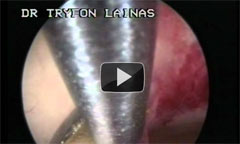Endometrial adhesions are responsible for subfertility, recurrent miscarriages, secondary amenhorroea (absence of a menstruation), haematometra (accumulation of blood within the uterine cavity) and oligomenhorroea (abnormally infrequent menstruation or abnormally scanty blood flow during menstruation). The pathophysiological are the ablation/curettage of the uterus, especially after delivery and septic miscarriage and more rarely endometritis caused by tuberculosis. A medical history that shows absence of menstruation following ablation raises a serious clinical suspicion and such finding are confirmed with hysterosalpingography and hysteroscopy.Endometrial adhesions are an important cause of subfertility and should be treated with hysteroscopic surgery techniques under immediate guidance and vision.The blind separation of endometrial adhesions with scrappers is a procedure that belongs to the past. These days, the treatment of choice for endometrial adhesions is the hysteroscopic separation under immediate vision and guidance.
The results of separating the adhesions depend on their extend, location, thickness and their morphology (thin and transparent, solid and fibrous). Also, the results of such a procedure with regards to pregnancy success and reappearance of a normal menstrual cycle are usually excellent.
An exception to such good results after hysteroscopic surgery is Asherman syndrome, which is characterized by the extended adhesion of the uterine cavity walls: this results to the absence of a uterine cavity and the absence of a menstruation. In 1948, Asherman described as "traumatic amenorrhoea" the secondary amennorrhoea that results following a traumatic ablation of the uterus, especially after parturition or septic miscarriages. Restoring the uterine cavity after lysis of the extended adhesions in Asherman syndrome is exceptionally difficult or even impossible.
































